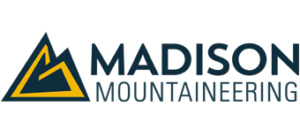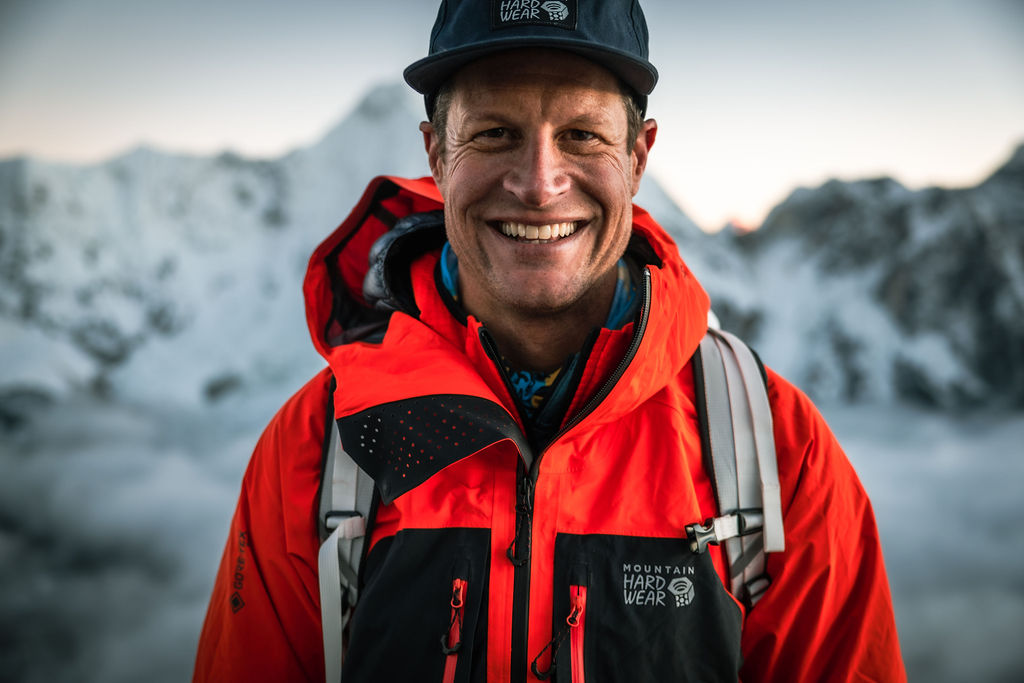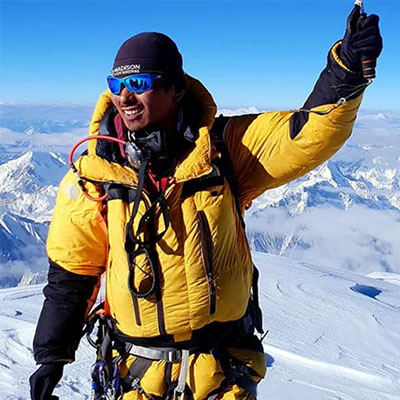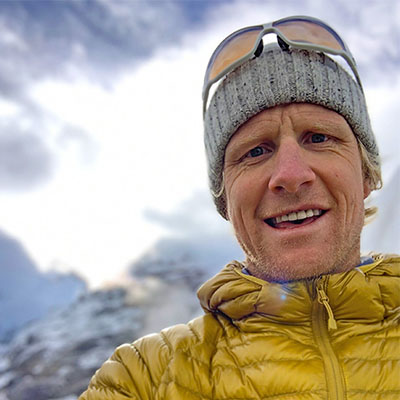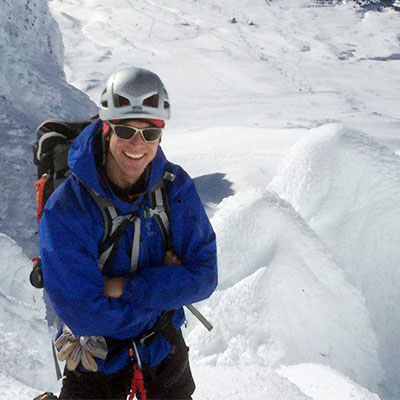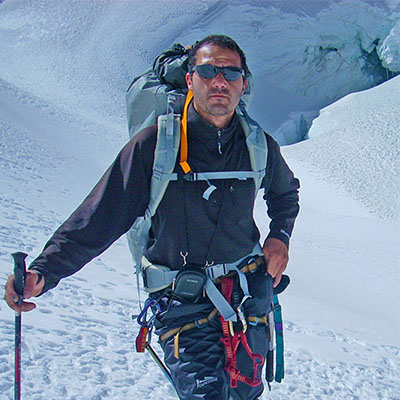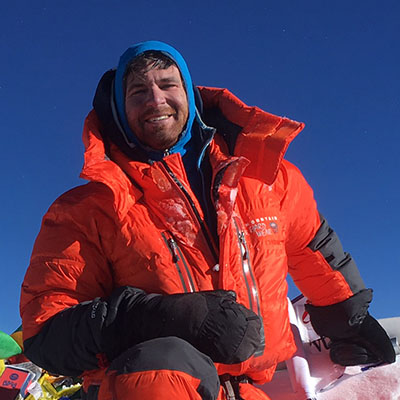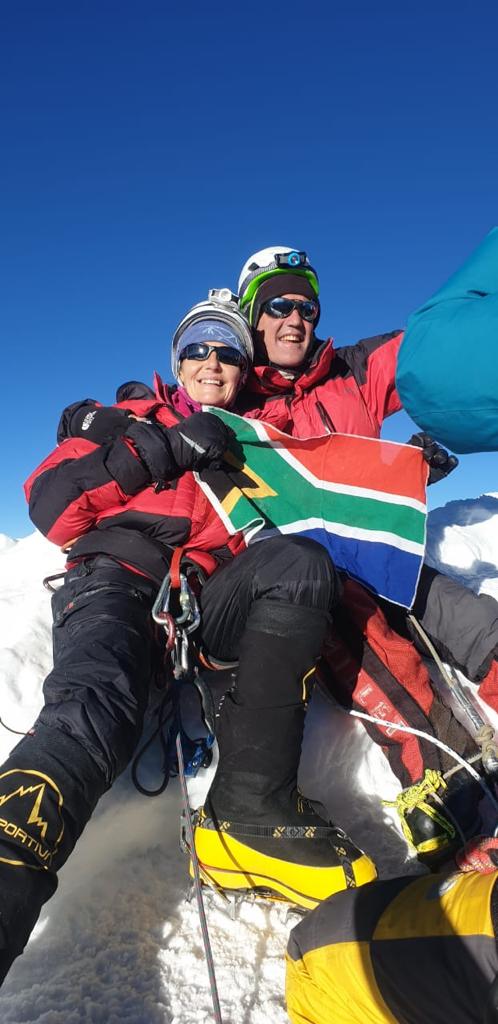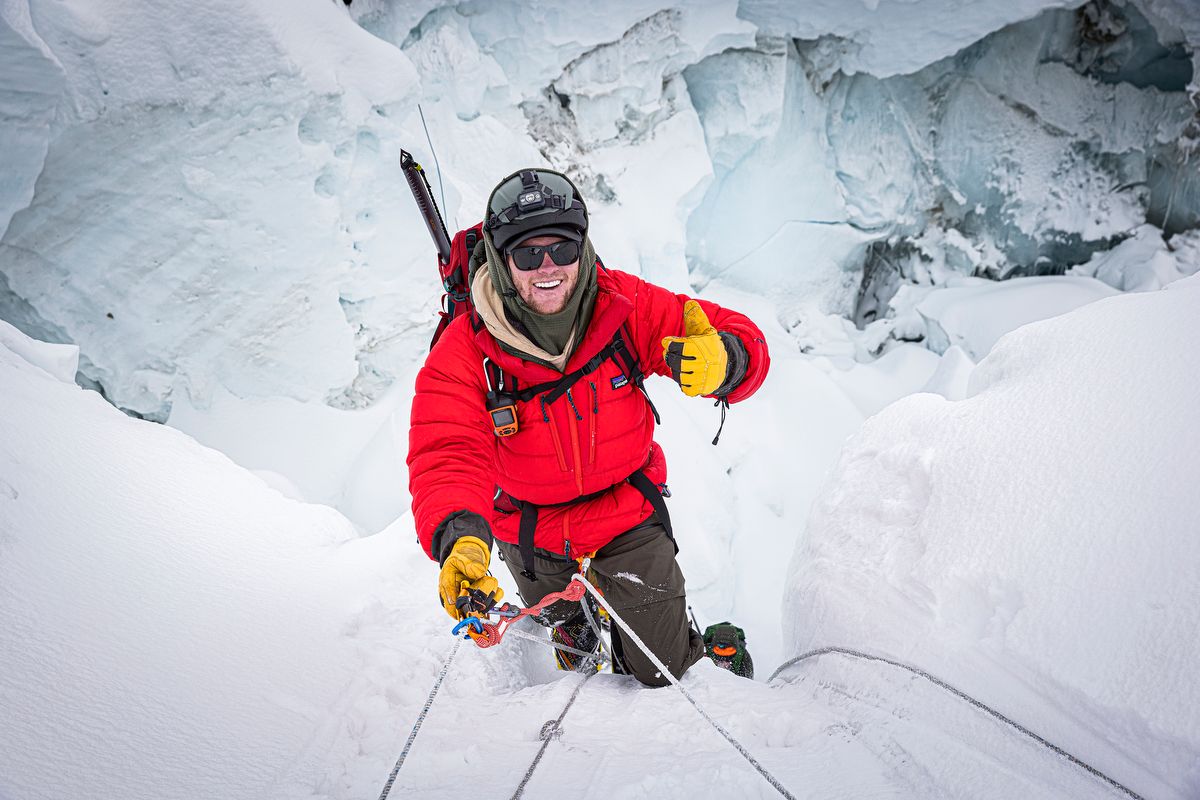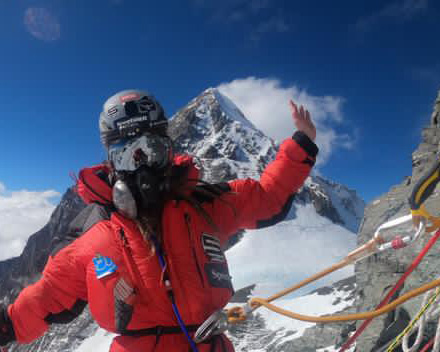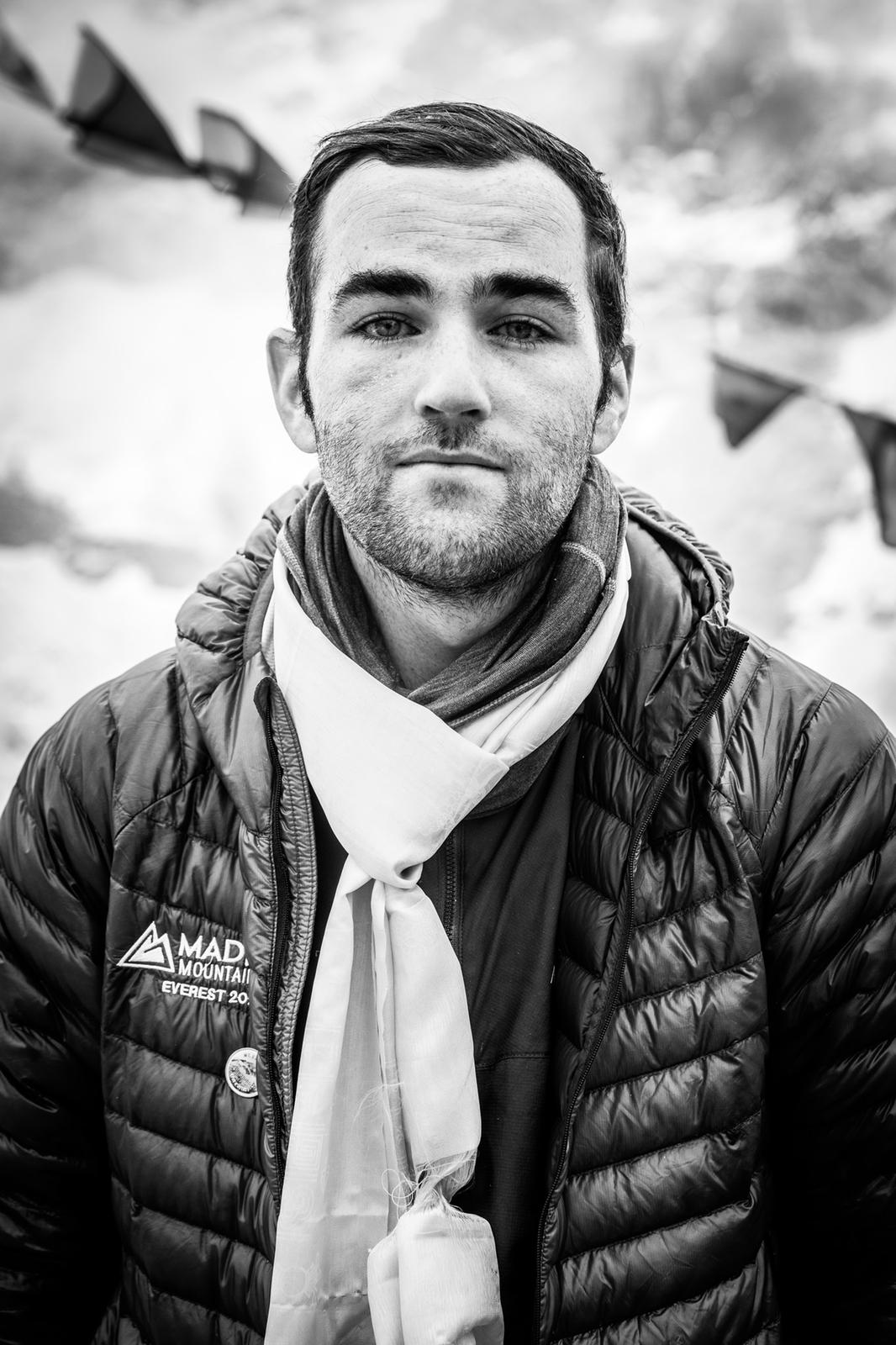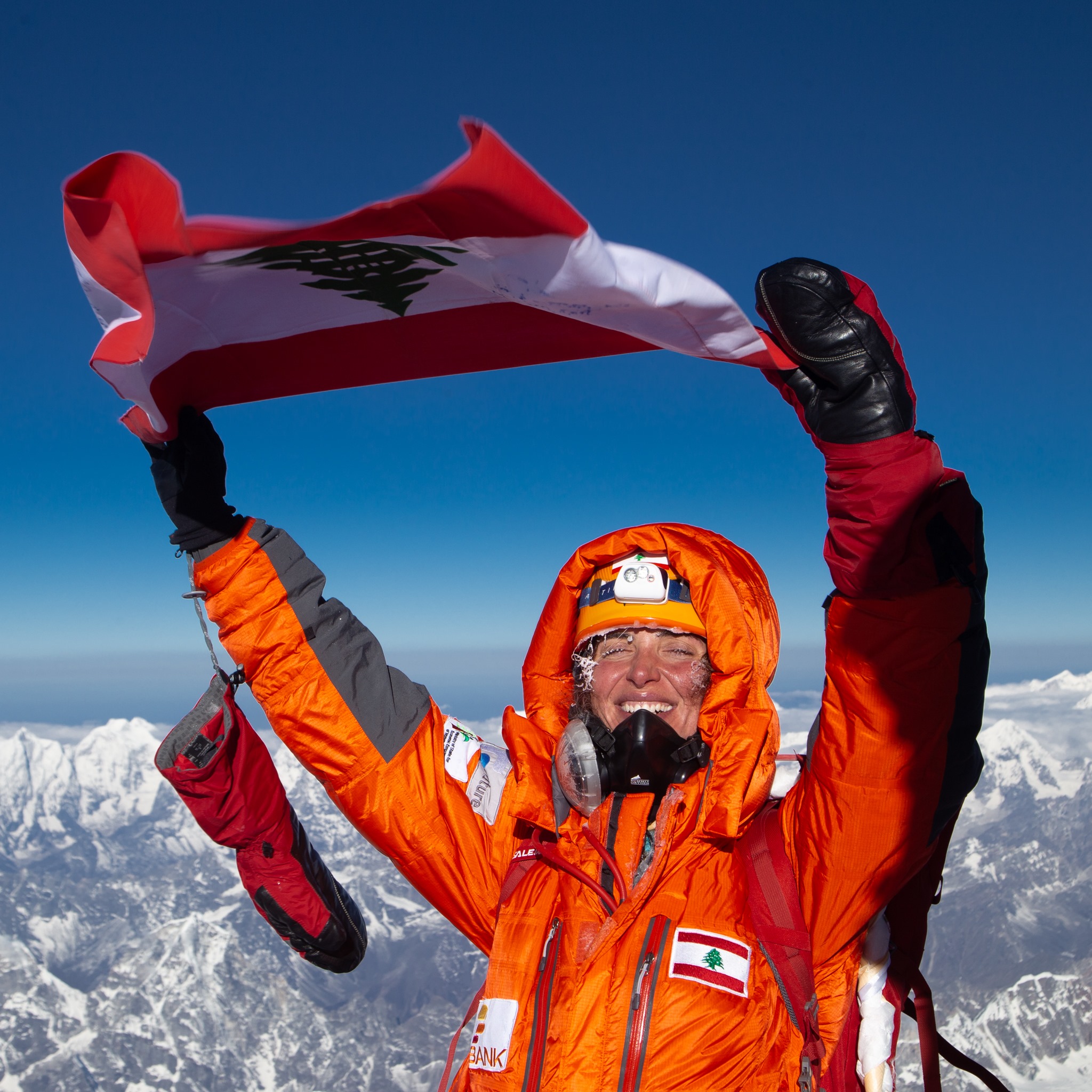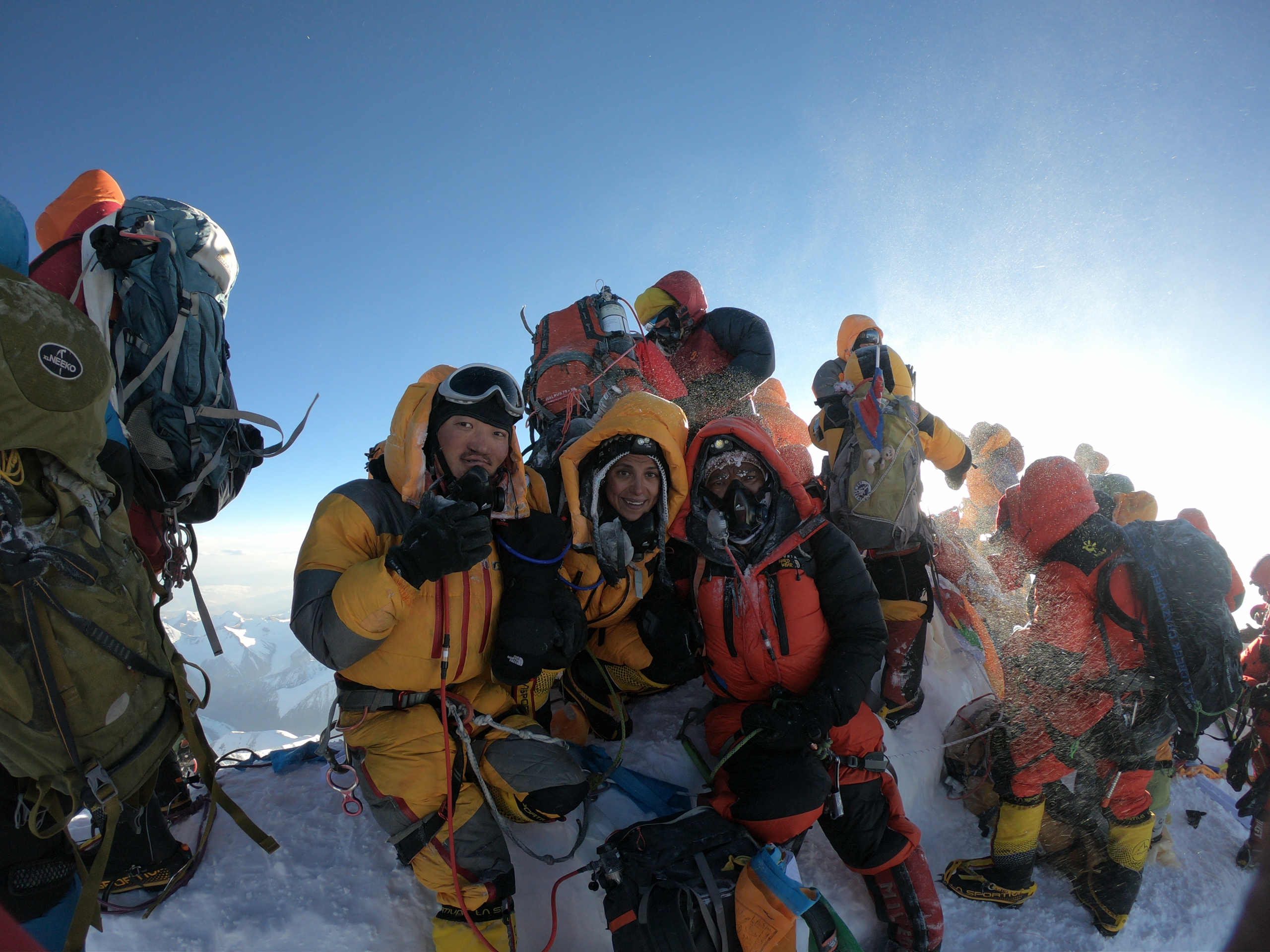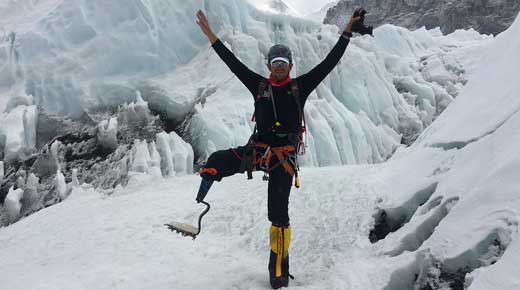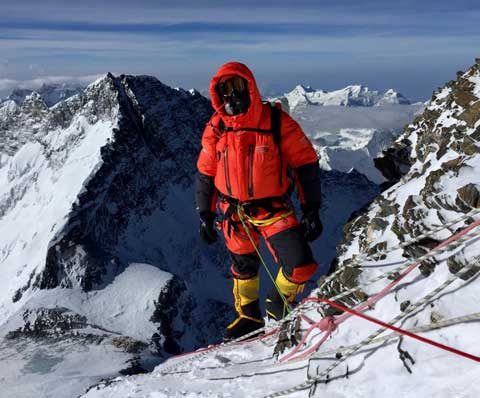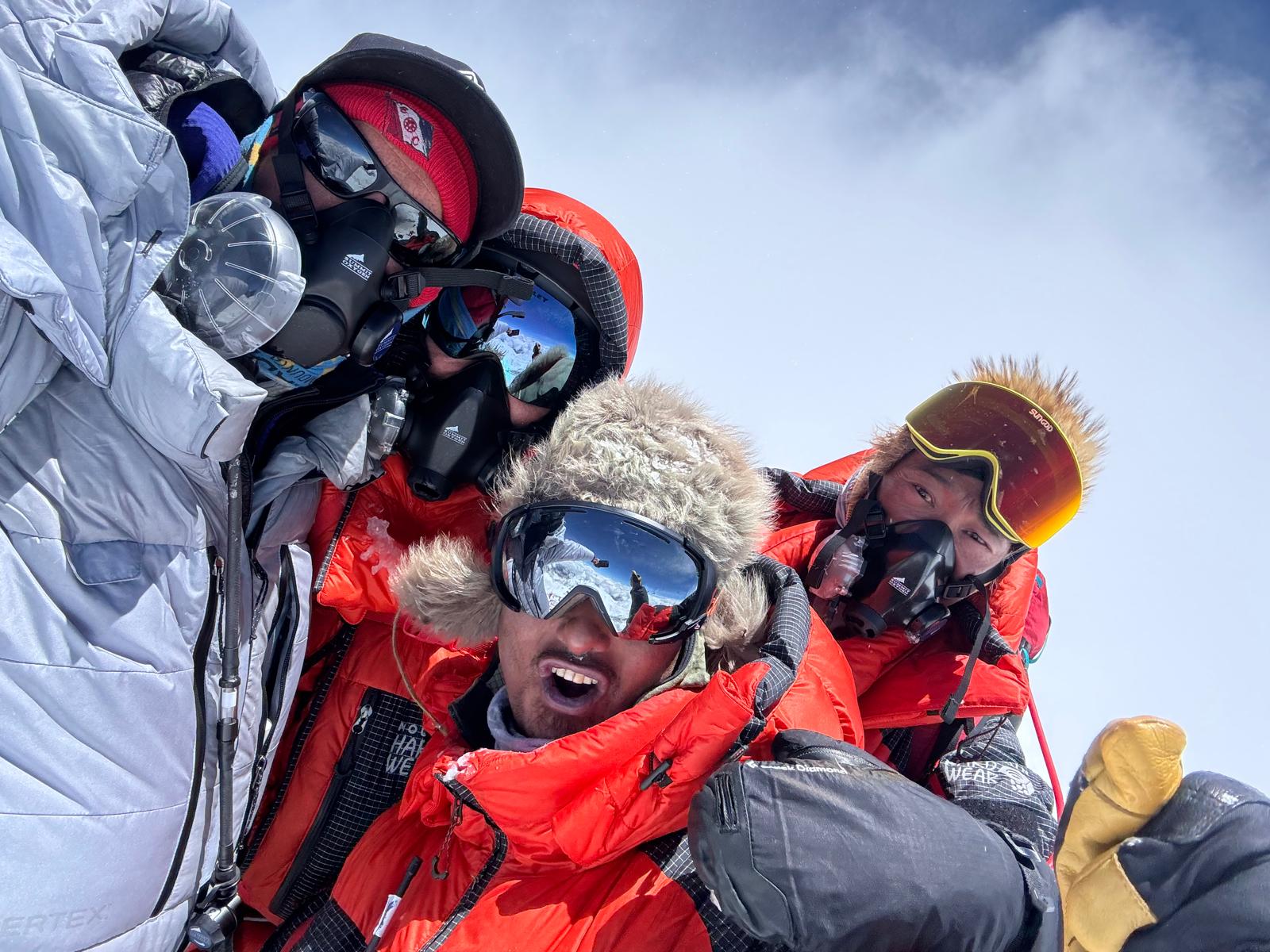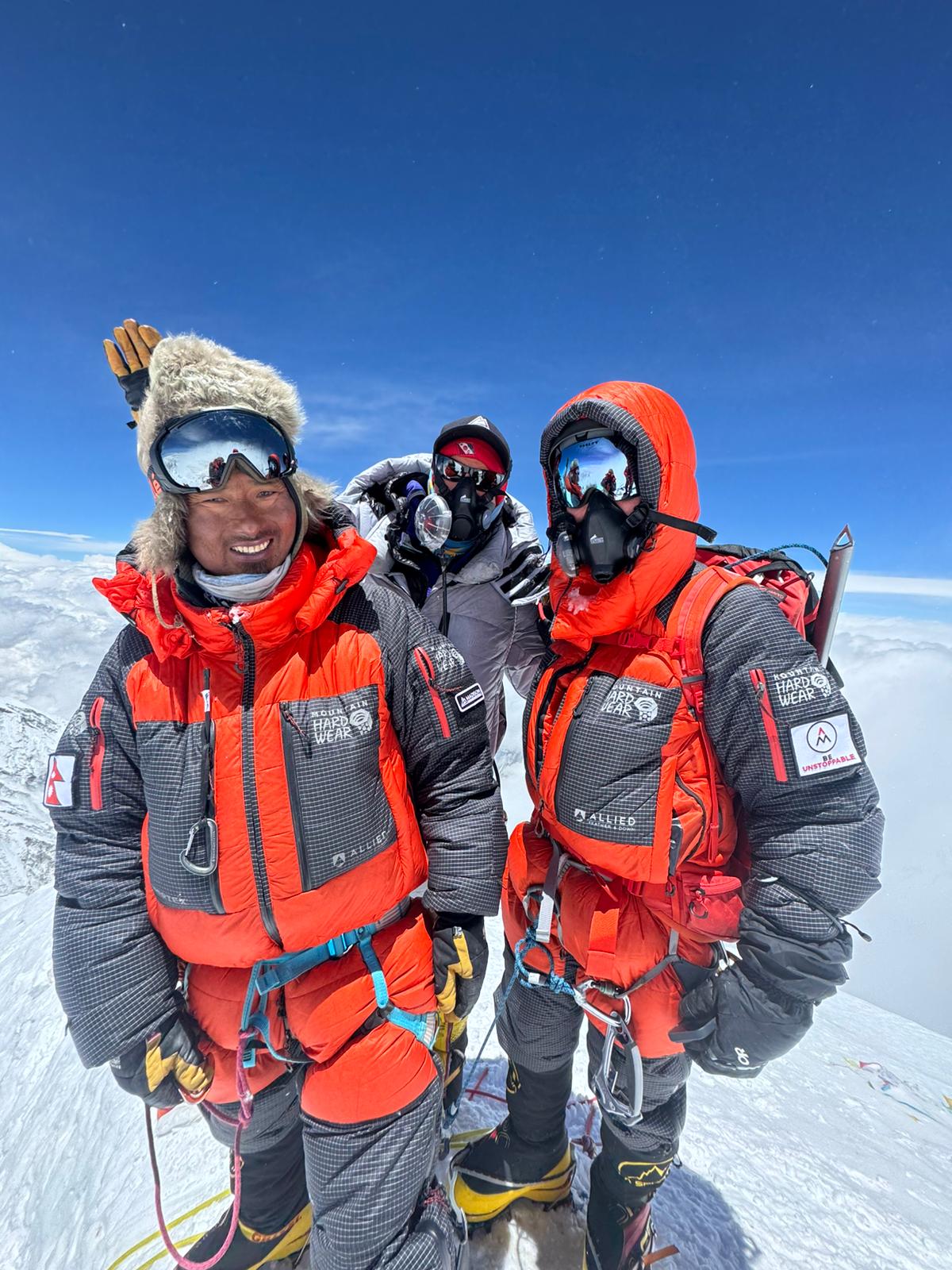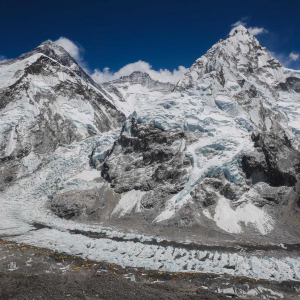Our Expedition Leader: Expedition Leader and Guide on Mount Everest, Garrett Madison oversees all aspects of his teams related to planning, organization, and climbing on Mount Everest. One of the best known “Expedition Leaders” on Mount Everest with the highest success and safety record in recent years, Garrett has personally accompanied over 80 climbers (clients) up Mount Everest to the summit since 2009 (as well as many co guides and climbing Sherpas), more than any other guide or Expedition Leader. Garrett is known for “climber care,” making the well-being of his clients his number one priority; this is perhaps the most important differentiating factor in our expeditions compared to the others on Mount Everest. Garrett has recently climbed Mount Lhotse (4th highest mountain) a 5th time, guiding climbers on the “peak to peak” combination where members climb Mount Lhotse the day after reaching the top of Mount Everest. Garrett has been part of many “firsts” on Everest, such as the 2016 first ascent by an American with a prosthetic leg.
Our Everest Guides: After his 18th expedition to Mount Everest (the last 16 years as “Expedition Leader”), Garrett Madison has reached the top 15 times. Garrett has personally guided more climbers to the summit (80) over the last ten years than any other mountain guide or Expedition Leader. Our Everest guide team includes very experienced mountain guides with multiple Everest summits, such as Terray Sylvester, Cacho Beiza, Benny Leiber, Brent Bishop, some of the most experienced and capable Everest guides on the mountain. This vast amount of organizational and logistical expertise, combined with a commitment to provide the best possible services to ensure safety and success, make Madison Mountaineering the premier boutique guiding company on Mount Everest. Climbers will have an unparalleled opportunity for safely climbing to the summit and returning to base camp, as well as climbing Lhotse if desired. Enjoying the experience is a high priority, and our climbers can attest to having a great time throughout (please contact us for past Everest climber testimonials)! Our teams are different than large-scale operations where climbers are locked into specific dates for rotations and summit attempts, and may be one of many people sitting down to eat in the dining tent, or dealing with illness spreading throughout the group. Often these large groups have only a leader who remains in base camp and to coach members over the radio, while with our team your leader climbs with you to the summit and back, often making the crucial “mission critical” decisions on the spot, this is a big part of our high level of success and safety. By keeping our team small yet highly supported, we don’t compromise our standards in providing the best strategy, flexibility, and resources needed to succeed in the dynamic environment of Mount Everest. The equation for success and safety involves variables that can and often rapidly change such as: weather (wind speed, precipitation, temperature), acclimatization and health, climbing route (the route often changes daily through the Khumbu Icefall), and other climbers and teams (climbers needing assistance, evacuation, as well as periodic overcrowding on the route).
We can quickly adjust to changing conditions better than any other team. We have the best communication systems available to monitor the weather (along with a dedicated meteorologists), to communicate with other teams on the mountain to collaborate on the route, weather, rescues, and summit schedule. We have an experienced base camp manager, a menu plan developed by a certified nutritionist, and a helicopter available that can evacuate an injured or ill climber if necessary, from as high as Camp 3. Our Sherpas are among the finest and most respected on the mountain, as evidenced by our Sherpa team that fixed the ropes to the summit on in 2017, 2018, 2019 on Mount Everest and in 2023 & 2024 on Nuptse, as well as yearly rope fixing on K2. Being the only operator who successfully guided climbers to the summits of Everest, Lhotse, and Nuptse the past 2 seasons. We are a team that works together to accomplish our common goals of safety, success, and having fun. If you would like to know more, we invite you to contact us!
Mount Everest is a harsh environment. We take pride in creating a team that can not only reach the top but can also get down safely and survive, all while having fun together. We are one of the few teams that has the ability to support climbers in distress who are high on Everest, commonly called the “death zone” which is above 8000 meters. Generally every season on the mountain, our team provides medical support to climbers in need at Camp 4, the South Col, and contributes to the survival of other climbers.
Everest 2019 Spring Summary:
Congratulations to our Everest 2019 spring team in successfully climbing the world’s highest peak, but more importantly making it down safely! In contrast to what the media has portrayed, our experience on summit day was a pleasant one, due to a strong and experienced team. Our guides and Sherpas not only installed the fixed lines to the summit, which ‘opened’ the route on May 14th for all climbers on the south side of the mountain but also supported our climbers in a seamless climb of Mount Everest. The challenge of climbing Everest, coupled with the added uncertainty of the weather and other climbers on the route, can create adverse conditions. However, our team of professionals orchestrated a perfect expedition under the circumstances.
In my 17 expeditions to Everest, this was one of the finest teams of hard-working, competent, positive, and pleasant Nepal “Sherpas”, many of who I have climbed with for the last 5 years. Big thanks for these incredible guys who helped us make our extraordinary success possible!
Everest 2018 Recap, “The Leader” on Everest
I am very pleased to report that our team had 100% success and safety with all climbers who embarked on the summit attempt from Everest base camp reaching the top between May 14 and May 18. Our small private teams (Kenton Cool’s group with Ben Fogel & Mark Fisher, the team of Ant Middleton & Ed Wardle) along and our main team of climbers all succeeded in the endeavor of climbing to the top of Everest and descending safely. We also had climbers complete the Everest and Lhotse combination climb, going from the summit of Mount Everest to the summit of Mount Lhotse the next day, altogether 42 climbers from our group (climbers and Sherpas) reached the summit of Mount Everest. As in previous Everest seasons, there were no injuries or accidents among our climbing team. We were supported by our incredible team of Sherpas who are an integral part of our success. Once again, as in the past 2017, season our team "led the way" by fixing the lines to the summit of Mount Everest, thereby opening the route for all teams to climb Mount Everest.Most Successful Everest Season Ever?
This season on Mount Everest is likely the most successful ever, given the number of collective summits versus permits issued and taking into account overall accidents/fatalities. Two reasons can explain this very high level of success, the fact that our rope fixing team opened the route earlier than in previous Everest seasons and because a period of very good weather then manifest which allowed climbers to take advantage of the open route and good mountain conditions to climb. Because our rope fixing project was on time and well communicated with teams in Everest base camp, climbers were able to plan and prepare for summit attempts in advance of the good weather that materialized May 13th onward. Our rope fixing team had to work hard, despite unfavorable conditions in April and early May such as a very icy Lhotse Face combined with high winds, our team was still able to fix the ropes to the summit of Mount Everest by May 13th, with double lines in places to ease congestion on the Lhotse Face up to Camp 3, the Yellow Band, and on the Geneva Spur. The rope used was 10.5 mm static rope, a very strong and durable rope, the anchors (primarily Black Diamond 22 cm ice screws) were placed appropriately to support many climbers.The small number of accidents/fatalities this season was unfortunate but on average less than what we normally see on Everest. Generally, there are some accidents/fatalities related to climbers getting stuck up high on Everest in bad weather or on a very crowded summit day and then running out of oxygen (I was witness to this in 2012 when 4 climbers perished up high on Everest because the rope fixing was delayed to May 18th and few good weather days were available). Because the weather window was favorable, climbers were able to spread out summit attempts over a week-long period, so that no single day was problematic from a congestion standpoint. Additionally, because our rope fixing project was well planned and executed on schedule, climbers were able to take advantage of the good weather window by making plans in advance of the arrival of this stable weather period.
Looking Forward
The rope fixing project this year was coordinated by my team, Adventure Consultants and our local operator in Nepal, Himalayan Guides. Initially, there was some contention from other teams that this was a good idea, as traditionally the rope fixing project was managed by the ‘old guard’ on Everest and the work shared by many teams. However, the challenge of managing members from many teams often led to some confusion regarding workdays and lost efficiency when Sherpas from different teams worked together for the first time. Our approach, keeping the project contained within essentially one team, provided us the opportunity to utilize our most capable high altitude Sherpas to complete this difficult project in an efficient and safe manner. Myself and Guy Cotter (CEO of Adventure Consultants) both climbed Mount Everest & Mount Lhotse this season, so we were able to actually be on the mountain to oversee and inspect various aspects of the rope fixing project ourselves in real-time rather than manage from Everest base camp as was traditionally the case by the teams in charge. I believe this “hands-on” approach by the leadership influenced the rope fixing project in a very positive manner, evident by the outcome. I hope this example, where the end result is safer and more successful climbing on the world’s highest mountain, can be carried forward to future seasons on Mount Everest! -- Garrett Madison2017: Highest Success & Safety Two Years Running:
Our 2017 Mount Everest Expedition was again a fantastic success, with 100% of our 8 clients who reached Camp 2 making the summit of Everest on May 21st and May 23rd, along with 4 American guides, and 15 Sherpas!! We also were the only company that had several of our climbers complete the Everest & Lhotse “peak to peak” combination, where they climbed Mount Lhotse (4th highest mountain) the day after reaching the summit of Mount Everest. This amazing and unmatched level of success among all the teams on Mount Everest is secondary to our number one priority, that all members (clients, guides, & Sherpas) made it safely off the peak.Rope Fixing to the Summit:
Our team took the lead in partnership with the British – Nepal Gurkha team in fixing the ropes to the summit of Mount Everest on May 15th, 2017. This was not part of our original plan, as the rope-fixing project was taken upon by several other teams at the start of the season. Unfortunately, after several mishaps, the lead team had to abandon the rope-fixing project along with their partners. Without any clear consensus on how or when the lines would be put-in to the summit, our team stepped up to finish the job. This “mission critical” project was necessary so that teams could begin their summit attempts on Mount Everest, with teams reaching the summit the following day on May 16th and continuing to reach the summit as late as May 28th. We are glad that our team had the capability and prowess to organize and execute such an important task, when no other teams on the mountain could summon such an effort, at such a critical stage in the climbing season.Rescues:
Our team was at the South Col when several climbers who had pushed themselves very hard on summit day returned and needed critical medical attention. Our guides came to assist with medicine (dexamethasone, etc) and supplemental oxygen. However, what stands out the most is that one of our veteran guides, Brent Bishop, along with our Sherpas, rescued the Slovak Climber from the Balcony (27,500’), lowering him all the way down to the South Col high camp. We gave oxygen for him to use on the descent. This heroic effort by Brent and our Sherpas involved abandoning their own summit attempt, just hours away from the top, and spending the day giving their all in an effort to save a life.We feel very fortunate that our expedition was a stunning success. We attribute this to our careful team selection and training, our top-notch and very experienced Everest guides and leadership, and of course our incredible Sherpa team who we invest heavily in year after year.
2016 Expedition Recap:
100% of our 2016 Everest Climbers reached the summit, of those that embarked on the summit attempt a total of 27 climbers (clients, guides and sherpas) reached the top of the world on May 19th, 2016!!- Itinerary
- Dates and Costs
- Gear List
- Everest - Lhotse Combo
- Everest Express Itinerary
- Why Madison Mountaineering?
Mount Everest Itinerary: Climb Everest in 41 days
Please contact us to learn about our finely tuned acclimatization and climbing strategy as it relates to our Mount Everest Expedition.
Day 01: Arrive in Kathmandu
Day 02: Fly to Lukla and begin the trek to base camp (stay in Phakding)
Day 03: Trek to Namche
Days 04: Rest in Namche, Everest View Point, etc.
Day 05: Trek to Debuche
Day 06: Trek to Pheriche (visit Pangboche enroute)
Day 07: Rest in Pheriche, acclimatization hike
Day 08: Trek to Lobuche
Day 09: Trek to Gorak Shep, hike up Kala Pattar
Day 10: Trek to base camp
Days 11-13: Acclimatize and review mountaineering technique (ladder practice, fixed lines, etc.) in base camp, Puja ceremony
Day 14: Trek to Lobuche
Day 15: Climb to Lobuche high camp
Day 16: Summit day on Lobuche East, return to Lobuche
Day 17: Return to Everest base camp
Day 18-19: Rest in base camp, review Khumbu icefall training
Day 20: Climb to Camp 1
Day 21: Rest in Camp 1
Day 22: Climb to Camp 2
Day 23: Rest in Camp 2 (hike up west shoulder)
Day 24: Touch Camp 3, sleep in Camp 2
Day 25: Descend to base camp
Days 26-31: Descend and rest in Debuche or Namche, evaluate weather conditions for summit rotation
Day 32: Begin summit push. Climb from base camp to Camp 2
Day 33: Rest in Camp 2
Day 34: Climb to Camp 3 (use O2)
Day 35: Climb to Camp 4 (use O2)
Day 36: Rest in Camp 4 (use O2)
Day 37: Everest Summit attempt. We make an alpine start for our summit attempt (use O2) and return to Camp 4
Day 38: Descend to Camp 2
Day 39: Descend to base camp
Days 40: Begin trek to Lukla or fly from base camp to Lukla – Kathmandu
Day 41: Depart for home
Days 42-49: Extra days in case of bad weather, etc. (contingency)
Actual schedules subject to change due to route conditions, weather, and climber health
Standard Mount Everest Program
- April 13 – May 25, 2026
Deposit: USD 25,000
Mount Everest and Lhotse Combination Climb
- April 13 – May 25, 2026
Deposit: USD 25,000
Mount Everest Express Climb
April 26 – May 25, 2025
Cost: USD 85,000
Deposit: USD 25,000
Costs include:
- Airport pick up in Kathmandu
- 3-night accommodations in Kathmandu at Hotel Yak & Yeti or similar – two nights before and one night after the trek and climb
- Welcome dinner in Kathmandu
- Lodging for all nights during the treks to and from base camp
- Expedition tents during the climb
- All food during the trek and climb – we provide high-quality food from the USA and Nepal, accommodating your specific dietary requirements
- All transportation in Nepal, including a round-trip flight from Kathmandu to Lukla
- All group equipment needed to climb the mountain: cooking gear, fuel, stoves, ropes, all forms of rock, ice, and snow protection, radio communications, oxygen delivery system and oxygen cylinders, medical supplies, etc.
- Sherpa, porters, liaison officer, camp staff, and American mountain guides
- All administration fees owed to Nepal, including climbing permits
Costs do not include:
- Bank and wire transfer fees (if applicable)
- Round-trip airfare to Kathmandu, Nepal to join and depart the expedition
- Optional one-way shared helicopter departure from Everest base camp to Kathmandu (approximately USD 2,000) – maximum of 2 duffel bags/person. Some climbers prefer to trek out in 3 days, while some prefer to fly out.
- Meals in Kathmandu
- Extra hotel nights after the trek and climb (once the climber has left the mountain). If we get delayed in Kathmandu, climbers are responsible for additional nights.
- Personal gear for any standard 8000-meter peak expedition, clothing, and sleeping equipment (see gear list)
- Wi-Fi Internet access while on the trek or at base camp (scratch card access codes available for approximately USD 50 per GB)
- Satellite phone calls (limited use available at approximately USD 3 per minute)
- Medical or evacuation costs
- Medical evacuation insurance (REQUIRED)
- Trip interruption/cancellation insurance (highly recommended)
- Comprehensive medical exam – a physician signed Medical Certification is required
- Alcoholic beverages / bottled or canned beverages / specialty coffee or espresso drinks
- All expenses incurred in the event of early departure (evacuation fees, transport, extra hotel nights, etc.)
- Personal items
- Personal purchases, for example, laundry services, souvenirs, gratuities for lodge staff, blessings, massages, etc.
- Charges incurred as a result of delays beyond the control of Madison Mountaineering
- Personal communication (phone, fax, email, etc.) between Nepal and home country
- USD 1,500 summit bonus for each of your Climbing Sherpa(s)
- Western guide(s) gratuities
Overall, a climber should budget a minimum of 10% of the total trip cost as gratuities for the expedition staff
Cancellation/Refund Policy:
- There are no refunds for the deposit or balance payments for this expedition. This includes but is not limited to, expeditions that conclude without reaching or making progress towards expedition objective(s) (for example, the summit) due to route conditions, weather, insufficient workforce, or any other factor outside the control of Madison Mountaineering
- Expedition leader has the final say on the expedition conclusion and will make all best efforts towards reaching expedition objective(s) within our margin of safety
- Participants that choose to leave an active expedition for any reason are not entitled to any refunds
- No refunds for expedition services not used
- Madison Mountaineering highly recommends trip cancellation insurance for all expeditions
- Due to the nature and high costs of government and operator permits, Madison Mountaineering must adhere to a stringent refund policy
- Deposit due with registration materials
- All balances are due 120 days prior to departure date unless otherwise specified
- Participants whose balances are not received by the 120-day deadline as stated above risk forfeiture of their funds and their place on the expedition
Note: Madison Mountaineering reserves the right to waive any fees. As we offer personalized service, we will attempt to accommodate changes and cancellations when necessary, waiving certain fees when feasible. Deposits paid by participants acknowledge the above cancellation terms.
Base Layers
- Synthetic Short Underwear (2-3 pair): non-cotton style underwear
- Lightweight Long Underwear (2-3 pair): long sleeve shirt and long pants
- Heavyweight Long Underwear (1 pair)
- Short Sleeve Synthetic Shirt (1-2 pair)
Mid Layer
- Soft Shell Jacket: to be worn over other layers
- Soft Shell Pants: very breathable and water repellant
- Lightweight Nylon Pants (1-2 pair)
Waterproof/Rain Layers
- Hard Shell Jacket with hood: waterproof and breathable shell jacket
- Hard Shell Pants: waterproof and breathable shell pants
Insulation Layers
- Heavyweight Insulated Down Jacket with hood: we primarily wear this when climbing below Camp 2
- Insulated Pants: worn primarily when climbing below Camp 2
- Down Suit: worn when climbing above Camp 2
Headwear
- Warm Hat: synthetic or wool hat (ski hat)
- Balaclava: to protect your neck and face in high winds
- Baseball Cap or other sun hat: to shade your face/neck from the sun on a hot day
- Bandana or Buff: to protect your neck/face from the sun
- Vapro Airtrim Cold Air Breathing Mask – Sport (optional)
Eyewear
- Glacier Glasses: full protection with side covers or wrap around
- Ski Goggles: to be worn on summit day in the event of high winds – (2nd pair optional)
Gloves
- Lightweight Synthetic Base Layer Gloves: for wearing on a hot day
- Soft Shell Gloves: to wear for moderate cold/wind
- Shell Glove with Insulated Liner: to wear for severe cold/strong wind
- Expedition Mitts: large enough to fit a liner glove inside
- Heated Gloves (optional): Battery-powered heated gloves
Footwear
- Liner Socks (3 pairs)
- Wool or Synthetic Socks (6 pairs)
- Heated Socks (optional)
- Mountaineering boots
- Hiking Boots/Shoes: comfortable boots or shoes for the trek to base camp
- Camp boots: comfortable boots for wearing in camp
- Shower shoes/sandals (optional)
- Lodge Slippers (optional): comfortable slippers for wearing about trekking lodges
- Gaiters (optional)
- Booties (optional)
Sleeping Equipment
- Sleeping Bag (for high camps): rated to at least -40°F. Goose down or synthetic
- Sleeping Bag (for base camp): rated to at least -20°F
- Self-inflating Sleeping Pad: full length is preferred
- Closed-cell Foam Pad: to be used in conjunction with the inflating pad for warmth and comfort when sleeping
- Earplugs
Mountaineering Gear
- Expedition Backpack: approximately 75 – 105L
- Compression Stuff Sacks: for reducing the volume of the sleeping bag, down parka, etc., in your pack
- Trash Compactor Bags: to line backpack and stuff sacks as well as for separating gear
- Backpack Rain Cover (optional)
- Trekking Backpack: to carry on the trek to base camp. Simple and light.
- Trekking Poles with Snow Baskets: adjustable poles
- Ice Axe: general mountaineering tool (65cm)
- Crampons: general mountaineering crampons
- Climbing Helmet: must be able to fit over your warm hat
- Ascender: 1 right or left-hand ascender
- Accessory Cord: 30 feet (9m) of 6mm accessory cord
- Alpine Climbing Harness: mountaineering harness, with adjustable leg loops. Not a rock-climbing “sport” harness
- Carabineers: 3 regular and 3 locking
- Carabineer for progression lanyard (locking)
- Belay/Rappel device
- Headlamps (2): bring a spare with 3 extra sets of new batteries
- Pack Liner (2 pieces)
Travel Items
- Large Duffel Bags with Locks (2): for transporting gear
- Carry-on Backpack: can use trekking backpack, approximately 24” x 12” x 7” (60cm x 29cm x 17cm)
- Travel Clothes: for days in cities and towns
- Lightweight journal, sketchbook, pencils, pen
- U.S. cash: for currency exchange to purchase Wi-Fi access scratchcards on the trek or in base camp and other random merchandise in cities and villages
Additional Food Items
- Snack Food: bring around 5kg (~11 lbs) of your favorite climbing snack food such as bars, gels, nuts, beef jerky, etc.
variety of salty and sweet is good
Other Equipment
- Cup: plastic 16 oz. minimum cup or mug
- Bowl: large plastic bowl for eating dinner or breakfast
- Spoon: long-handled plastic spoon (Lexan)
- Water Bottles (2 or 3): wide mouth bottles with 1-liter capacity
- Water Bottle Parkas (2): fully insulated with zip opening
- Water Treatment (optional): UV-based or tablets
- Thermos: 1 liter
- Heated Insoles (optional): battery powered for your boots
- Hand Warmers
- Sunscreen: SPF 50 or better
- Lip Screen (2 sticks): SPF 30 or better
- Toiletry Bag: include toilet paper and hand sanitizer
- Pee bottle: 1-liter minimum bottle for convenience at night in the tent
- Female Urination Device (FUD)
- Knife or Multi-tool (optional)
- Small Personal First-aid Kit: include athletic tape, band-aids, Ibuprofen, blister care, cough drops, etc.
- Foot Powder
- Medications and Prescriptions: bring antibiotics (Azithromycin, etc.), altitude medicine such as Diamox and dexamethasone, and sleep aids such as Ambien/zolpidem, melatonin, magnesium (calm powder)
- Handkerchiefs/Bandanas (optional)
Optional Electronics
- Country-appropriate power plug adapters and power transformers
- Adventure Sports Watch: such as Garmin fēnix 6
- GPS/Personal Satellite Communicator: such as Garmin inReach Mini
- Personal Power System: such as Goal Zero Nomad 28 Plus Solar Panel and Sherpa 100AC Power Bank
- Digital Entertainment: movies, tv shows, music, books loaded on to smartphone, iPad, Kindle
- Camera: bring extra batteries, charger, and memory cards
- Portable Travel Humidifier: battery powered
Everest – Lhotse Combo Itinerary: Climb Mount Everest and Lhotse in 41 days
Please contact us to learn about our finely tuned acclimatization and climbing strategy as it relates to our Mount Everest and Lhotse Combination Expedition.
Day 01: Arrive in Kathmandu
Day 02: Fly to Lukla and begin the trek to base camp (stay in Phakding)
Day 03: Trek to Namche
Days 04: Rest in Namche, Everest View Point, etc.
Day 05: Trek to Debuche
Day 06: Trek to Pheriche (visit Pangboche enroute)
Day 07: Rest in Pheriche, acclimatization hike
Day 08: Trek to Lobuche
Day 09: Trek to Gorak Shep, hike up Kala Pattar
Day 10: Trek to base camp
Days 11-13: Acclimatize and review mountaineering technique (ladder practice, fixed lines, etc.) in base camp, Puja ceremony
Day 14: Trek to Lobuche
Day 15: Climb to Lobuche high camp
Day 16: Summit day on Lobuche East, return to Lobuche
Day 17: Return to Everest base camp
Day 18-19: Rest in base camp, review Khumbu icefall training
Day 20: Climb to Camp 1
Day 21: Rest in Camp 1
Day 22: Climb to Camp 2
Day 23: Rest in Camp 2 (hike up west shoulder)
Day 24: Touch Camp 3, sleep in Camp 2
Day 25: Descend to base camp
Days 26-31: Descend and rest in Debuche or Namche, evaluate weather conditions for summit rotation
Day 32: Begin summit push. Climb from base camp to Camp 2
Day 33: Rest in Camp 2
Day 34: Climb to Camp 3 (use O2)
Day 35: Climb to Camp 4 (use O2)
Day 36: Rest in Camp 4 (use O2)
Day 37: Everest Summit attempt. We make an alpine start for our summit attempt (use O2) and return to Camp 4
Day 38: Lhotse summit attempt. After resting at Camp 4, we make an alpine start and begin our climbing (use O2) up the Lhotse couloir to the summit and then descend to Camp 2
Day 39: Descend to base camp
Days 40: Begin trek to Lukla or fly from base camp to Lukla – Kathmandu
Day 41: Depart for home
Days 42-49: Extra days in case of bad weather, etc. (contingency)
Actual schedules subject to change due to route conditions, weather, and climber health
Mount Everest Express Itinerary: Please contact us to learn about our finely tuned acclimatization and climbing strategy as it relates to our Mount Everest Express Expedition.
Day 01: Arrive in Kathmandu and fly to Pheriche. We will pick you up at the airport and take you to the Yak & Yeti hotel if you need a shower, sleep in Pheriche.
Day 02: Trek to Lobuche.
Day 03: Trek to base camp
Day 04 – 07: Acclimatize and review mountaineering technique (ladder practice, fixed lines, etc.) in base camp, Puja ceremony
Day 08: Climb to Camp 1
Day 09: Rest in Camp 1
Day 10: Climb to Camp 2
Day 11: Rest in Camp 2 (hike up west shoulder)
Day 12: Touch Camp 3, sleep in Camp 2
Day 13: Descend to base camp
Days 14 – 19: Descend and rest in Debuche or Namche, evaluate weather conditions for summit rotation
Day 20: Begin summit push. Climb from base camp to Camp 2
Day 21: Rest in Camp 2
Day 22: Climb to Camp 3 (use O2)
Day 23: Climb to Camp 4 (use O2)
Day 24: Rest in Camp 4 (use O2)
Day 25: Everest Summit attempt. We make an alpine start for our summit attempt (use O2) and return to Camp 4
Day 26: Lhotse summit attempt. After resting at Camp 4, we make an alpine start and begin our climbing (use O2) up the Lhotse couloir to the summit and then descend to Camp 2
Day 27: Descend to base camp
Day 28: fly from base camp to Lukla – Kathmandu
Day 29: Depart for home
Day 30-35: Extra days in case of bad weather, etc. (contingency)
*Schedule subject to change based on route conditions, weather conditions, and climber health.
Madison Mountaineering is recognized for well thought out strategy in leading high altitude climbing expeditions, as well as high-quality service throughout. We have two decades of experience in the planning and coordination of mountaineering expeditions, our reputation is excellent. We strive to make each expedition the best possible experience for our climbers and focus on our 3 primary goals of success in reaching the summit, returning safely, and having fun! Safety is always our number one priority.
Our guides are some of the best and most experienced in the industry, having a strong grasp of technical climbing, expedition, and high altitude experience, along with strong interpersonal skills. Our teams are small and equipped with the best support available to ensure the highest chance of success. We are renowned for our comfortable base camps, high-quality food, first-rate communications, and medical support services, all of which are overseen by a professional member of our team.
Most of our climbers have either climbed with us before, been referred by a friend who has climbed with us, or met one of our teams while attempting another peak and decided to join us for their next expedition. We work hard to facilitate safe, successful, and enjoyable expeditions for all of our climbers. Our track record and past climber testimonials prove we are highly competent experts in our field and love what we do!
